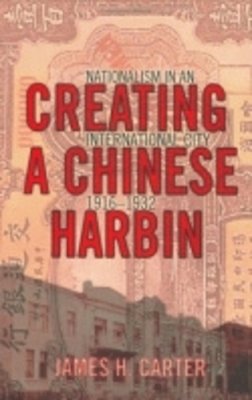
Stock image for illustration purposes only - book cover, edition or condition may vary.
Creating a Chinese Harbin
James H. Carter
FREE Delivery in Ireland
Description for Creating a Chinese Harbin
hardcover. Num Pages: 232 pages, 17. BIC Classification: 1FPC; 3JJF; 3JJG; HBJF; HBLW; JFS; JPFN. Category: (G) General (US: Trade); (P) Professional & Vocational; (UP) Postgraduate, Research & Scholarly; (UU) Undergraduate. Dimension: 229 x 152 x 21. Weight in Grams: 514.
James H. Carter outlines the birth of Chinese nationalism in an unlikely setting: the international city of Harbin. Planned and built by Russian railway engineers, the city rose quickly from the Manchurian plain, changing from a small fishing village to a modern city in less than a generation. Russian, Chinese, Korean, Polish, Jewish, French, and British residents filled this multiethnic city on the Sungari River. The Chinese took over Harbin after the October Revolution and ruled it from 1918 until the Japanese founded the puppet state of Manchukuo in 1932.
In his account of the radical changes that this ... Read moreunique city experienced over a brief span of time, Carter examines the majority Chinese population and its developing Chinese identity in an urban area of fifty languages. Originally, Carter argues, its nascent nationalism defined itself against the foreign presence in the city—while using foreign resources to modernize the area. Early versions of Chinese nationalism embraced both nation and state. By the late 1920s, the two strands had separated to such an extent that Chinese police fired on Chinese student protesters. This division eased the way for Japanese occupation: the Chinese state structure proved a fruitful source of administrative collaboration for the area's new rulers in the 1930s.
Show Less
Product Details
Publisher
Cornell University Press United States
Place of Publication
Ithaca, United States
Shipping Time
Usually ships in 7 to 11 working days
About James H. Carter
James H. Carter is Assistant Professor of History at St. Joseph's University.
Reviews for Creating a Chinese Harbin
James H. Carter deserves much praise for this eloquent and penetrating case stud of Chinese nationalism in the early twentieth century.... The book is a valuable contribution to the rapidly expanding body of literature on twentieth-century modernity and nationalism in individual Chinese cities.
Joseph W. Esherick, UC San Diego
The China Journal
The book builds on a ... Read moretruly impressive range of archival materials and publications in English, Chinese, Russian, Japanese, and even Danish. One of the problems involved in working on this particular city is that its multiethnic history makes research so linguistically demanding, but although Carter's focus is clearly on the Chinese community, he does not lose sight of the larger picture. Throughout the book, he shows a fine eye for the significance of events which at first sight might not appear to be important: a brawl between Russian and Chinese students after a basketball match; the Chinese takeover of a Danish Lutheran church; the fundraising activities of a Buddhist monk; the route of a student demonstration. Close analysis of such local events and individuals makes this very special city come alive on the page.
International History Review
Carter's story charts the rise of various competing versions of Chinese nationalism. These included an aggressive, violent, radical student version as well as a more peaceful, middle-class, merchant-oriented version.... Carter's conclusion is a disturbing one for those who hope that China will produce a civil society capable of supporting democratic practices. As he sees it, the efforts to 'Chineseify' Harbin illuminate the larger Chinese problem: that the state dominates society so much that the end result is a state without a nation.
Foreign Affairs
Graceful writing, interesting biographical sketches, and good illustrations make this urban portrait a pleasure to read, and the discussion of the development of Chinese nationalism is stimulating.... Summing Up: Recommended. All levels/collections.
Choice
The book contributes significantly to Republican Chinese history. First, it is a much-needed study of a city whose Chinese, as opposed to Russian, history has not been much explored in English before.... This elegantly written and meticulously researched book will repay attention from all those who are interested in urban history, imperialism, and nationalism in modern China.
Rana Mitter
China Quarterly
What should a modern Chinese city be like? Such a simple question, unfortunately, defies a simple answer. Focusing on Harbin in the Northeast, the author traces how generations of nationalistic Chinese who lived in the city through the tumultuous late nineteenth and early twentieth century wrestled with an answer, or answers. Condemned to modernize by Tsarist Russia and other imperialist powers, how did they negotiate the tensions of westernization and yet realize their nationalistic quest by fashioning a Chinese identity?
The China Review
Show Less

